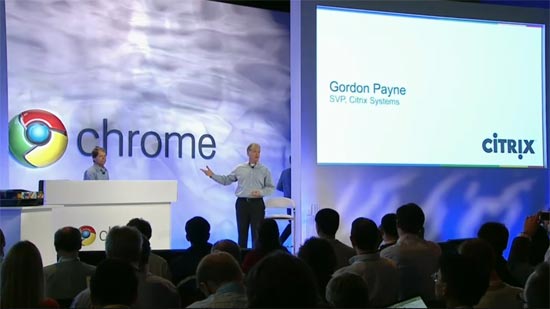Thin client adoption is picking up, improving the fortunes of startups like NComputing and prodding vendors to revamp their product portfolios. Sales of energy-efficient, TCO-lowering thin client hardware is expected to double to 7.4 million by 2014 from 2010’s scant 3.7 million units, according to IDC. Can Google and Citrix get in on the action while helping enterprises get thin and mobile?
This week saw the unveiling of Google’s Chrome OS, which leverages the cloud to keep users connected to their data. It didn’t blow anyone away, but it didn’t have to. It signaled to Google’s web services faithful that their next netbook is on the horizon.
By virtue of its browser-esque lineage, it supports nearly all of the functions associated with a digital lifestyle. Plus don’t forget that Google’s penchant for supporting common business file types (.doc .xls .ppt .pdf) means that you can get work done. It’s the result of the cloud’s ability to put the power that was once bestowed by IT teams in the hands of consumers. Yup, that “consumerization of IT” chestnut you’ve undoubtedly heard by now.
All well and good if you’re a heavy user of Google’s services. But most enterprises are loathe to entrust their apps and data to clouds not of their own making.
In comes Citrix to add some much-needed enterprise legitimacy to the proceedings. Because let’s face it, IT shops discriminate against consumer-grade products. It’s why Blackberry handsets are a dime a dozen in the corporate world but iPhones, iPads and Android remain a rarity.
In his blog post, Citrix’s Sumit Dhawan explains how his company’s Receiver software and Google’s Chrome Notebook, combats this.
Citrix’s solution to this problem is virtual apps and desktops along with Citrix Receiver – both designed to deliver any enterprise app or desktop to any user, anywhere. The mMajority of these are Windows based apps and soon to be adopted Windows 7 desktops…
Today, Citrix demonstrated an early version of Receiver for Chrome OS Notebook at the Google launch event, showcasing access to enterprise Windows based applications securely with a high definition experience. As with all versions of Citrix Receiver, customer demand is strong, making Receiver a “must have” app for new consumer devices. Google’s enterprise customers asked them to partner with Citrix Google Notebooks can have access to enterprise apps & desktops – most of them based on Microsoft Windows. Citrix Receiver for Chrome Notebook will be available in first half of 2011. Users will be able to download it from Google Chrome Web Store.
Sure sounds like a recipe for a mobile ‘thin’ client, doesn’t it? But first, Google has some serious wooing to do. Not only does it have dispel some lingering concerns, it has to line up more vendors besides early supporters Samsung and Acer. The good news here is that Dell has expressed an interest — unsurprising given its flirtation with Chrome OS — and according to Google’s Product Management Lead for Chrome, Sundar Pichai, his team has been “inundated with interest” from CIOs.
Let’s see if that interest materializes into adoption when Chrome OS hardware starts showing up next year.
Watch the relevant part of the Google Chrome OS/Citrix Receiver announcement in this YouTube video (skip ahead to the 21 minute mark):
Image Credit: Google


[…] This post was mentioned on Twitter by ecoINSITE, The Tech Gang. The Tech Gang said: #Citrix #Cloud Google Chrome and Citrix: Advent of the thinner, mobile enterprise …: Tagged as: Chrome OS… http://bit.ly/e6TCs9 #TCN […]